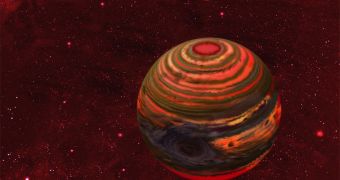An international group of astronomers announces the discovery of the smallest known brown dwarf, a type of cosmic object that lies at the boundary between as star and a gas giant. These failed stars can dwarf Jupiter or Saturn, and now experts have discovered the smallest of them.
The discovery could have important implications for understanding how and why these objects form in the first place. According to leading theories, brown dwarfs form from molecular hydrogen clouds that are insufficiently large to form a proper, Sun-sized star.
As the clouds collapse, they fail to trigger nuclear fusion, therefore failing to ignite. This is why brown dwarfs are called failed stars, experts explain. However, until now, experts always believed that there was some sort of mass limit for how small one of these objects could be.
While analyzing two relatively-young star clusters, astronomers were able to identify more than two dozens brown dwarfs, including the smallest one known to data. Observations were conducted with the Hawaii-based Subaru Telescope and the Chile-based Very Large Telescope (VLT).
The VLT is located at the La Silla Observatory, and is operated by the European Southern Observatory (ESO). It is made up of four primary telescopes and four tracking telescopes, whose light is combined together through optical interferometry.
In a statement the team released recently, the experts say that the newest collection of white dwarfs revealed a failed star that is about 6 times heavier than Jupiter. This is an extremely low mass, considering that the object did not form via accretion, but through hydrogen cloud collapses.
“Its mass is comparable to those of giant planets, yet it doesn't circle a star. How it formed is a mystery,” Aleks Scholz says. The expert, who is based at the Dublin Institute for Advanced Studies in Ireland, is the lead author of a paper detailing the findings, which will be published soon.
Interestingly enough, several of the newly-found brown dwarfs have very small masses. Most of the dozens of objects discovered in the NGC 1333 and Rho Ophiuchi stellar clusters are only 20 times the mass of Jupiter, which still places them at the low end of brown dwarf masses.
“Brown dwarfs seem to be more common in NGC 1333 than in other young star clusters. That difference may be hinting at how different environmental conditions affect their formation,” adds University of Toronto astronomer Koraljka Muzic, who authored another upcoming research paper.
“Our findings suggest once again that objects not much bigger than Jupiter could form the same way as stars do. In other words, nature appears to have more than one trick up its sleeve for producing planetary mass objects,” University of Toronto expert Ray Jayawardhana concludes, quoted by Space.

 14 DAY TRIAL //
14 DAY TRIAL //